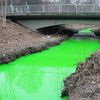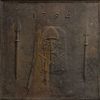3.

Sarkazmo 13 year s ago
Ummm... that's what is supposed to be in there. This is a very cheap one but that's basically what all those torches are. It's a source of butane (the lighter body, usually refillable,) a piezo igniter (which is used in electronic lighters,) and a nozzle that does the work of mixing oxygen and butane with the spark and you have a high temperature torch capable of melting pennies.
Dang and Gallinazo: You're both idiots.
Dang and Gallinazo: You're both idiots.
6.

Sarkazmo 13 year s ago
Yeah, I'm a nerd, big fucking deal?
The O2 is coming from the air we breathe. The air mixes with the butane gas, ignited by the spark from the piezo igniter. The pressurized butane and the shape of the nozzle accelerates the burning, expanding gasses creating the torch effect. What about this is so hard to understand. This is pretty basic stuff.
The O2 is coming from the air we breathe. The air mixes with the butane gas, ignited by the spark from the piezo igniter. The pressurized butane and the shape of the nozzle accelerates the burning, expanding gasses creating the torch effect. What about this is so hard to understand. This is pretty basic stuff.
8.

somenerd 13 year s ago
Yes, pocket torches run on butane, the same fuel found in an ordinary lighter.
The chemistry....Combustion (fire!) requires both fuel and oxygen (air).
When butane gas burns completely, with sufficient oxygen, it burns with a blue flame at 1300 degrees Celsius. With ordinary lighters the combustion of butane is incomplete, resulting in a yellow 'flame' due to the glowing particles of carbon oxidizing slowly to C02.
The physics....The reason for the different combustion properties of
pocket torches and ordinary lighters has to do with the 'head' (actually called a 'fire nozzle') that you described. This nozzle is basically a metal plate containing very small holes. Air is sucked in from another hole in the side of the nozzle and is then forced through the small nozzle holes.
The very small size of the holes causes a pressure build-up (and therefore very high gas flow velocity) which has two important effects.
First of all, enough air (oxygen) is drawn in to completely combust the butane.
Secondly, the resulting flame shoots straight out and is "strong"
enough to withstand windy conditions without blowing out. A good analogy is the effect of putting your finger on the end of a water hose. The smaller the opening, the greater the force of water exiting the hose.
The chemistry....Combustion (fire!) requires both fuel and oxygen (air).
When butane gas burns completely, with sufficient oxygen, it burns with a blue flame at 1300 degrees Celsius. With ordinary lighters the combustion of butane is incomplete, resulting in a yellow 'flame' due to the glowing particles of carbon oxidizing slowly to C02.
The physics....The reason for the different combustion properties of
pocket torches and ordinary lighters has to do with the 'head' (actually called a 'fire nozzle') that you described. This nozzle is basically a metal plate containing very small holes. Air is sucked in from another hole in the side of the nozzle and is then forced through the small nozzle holes.
The very small size of the holes causes a pressure build-up (and therefore very high gas flow velocity) which has two important effects.
First of all, enough air (oxygen) is drawn in to completely combust the butane.
Secondly, the resulting flame shoots straight out and is "strong"
enough to withstand windy conditions without blowing out. A good analogy is the effect of putting your finger on the end of a water hose. The smaller the opening, the greater the force of water exiting the hose.









Dang and Gallinazo: You're both idiots.
The O2 is coming from the air we breathe. The air mixes with the butane gas, ignited by the spark from the piezo igniter. The pressurized butane and the shape of the nozzle accelerates the burning, expanding gasses creating the torch effect. What about this is so hard to understand. This is pretty basic stuff.
The chemistry....Combustion (fire!) requires both fuel and oxygen (air).
When butane gas burns completely, with sufficient oxygen, it burns with a blue flame at 1300 degrees Celsius. With ordinary lighters the combustion of butane is incomplete, resulting in a yellow 'flame' due to the glowing particles of carbon oxidizing slowly to C02.
The physics....The reason for the different combustion properties of
pocket torches and ordinary lighters has to do with the 'head' (actually called a 'fire nozzle') that you described. This nozzle is basically a metal plate containing very small holes. Air is sucked in from another hole in the side of the nozzle and is then forced through the small nozzle holes.
The very small size of the holes causes a pressure build-up (and therefore very high gas flow velocity) which has two important effects.
First of all, enough air (oxygen) is drawn in to completely combust the butane.
Secondly, the resulting flame shoots straight out and is "strong"
enough to withstand windy conditions without blowing out. A good analogy is the effect of putting your finger on the end of a water hose. The smaller the opening, the greater the force of water exiting the hose.
Someone who bought chinese shit, is probably silly American.